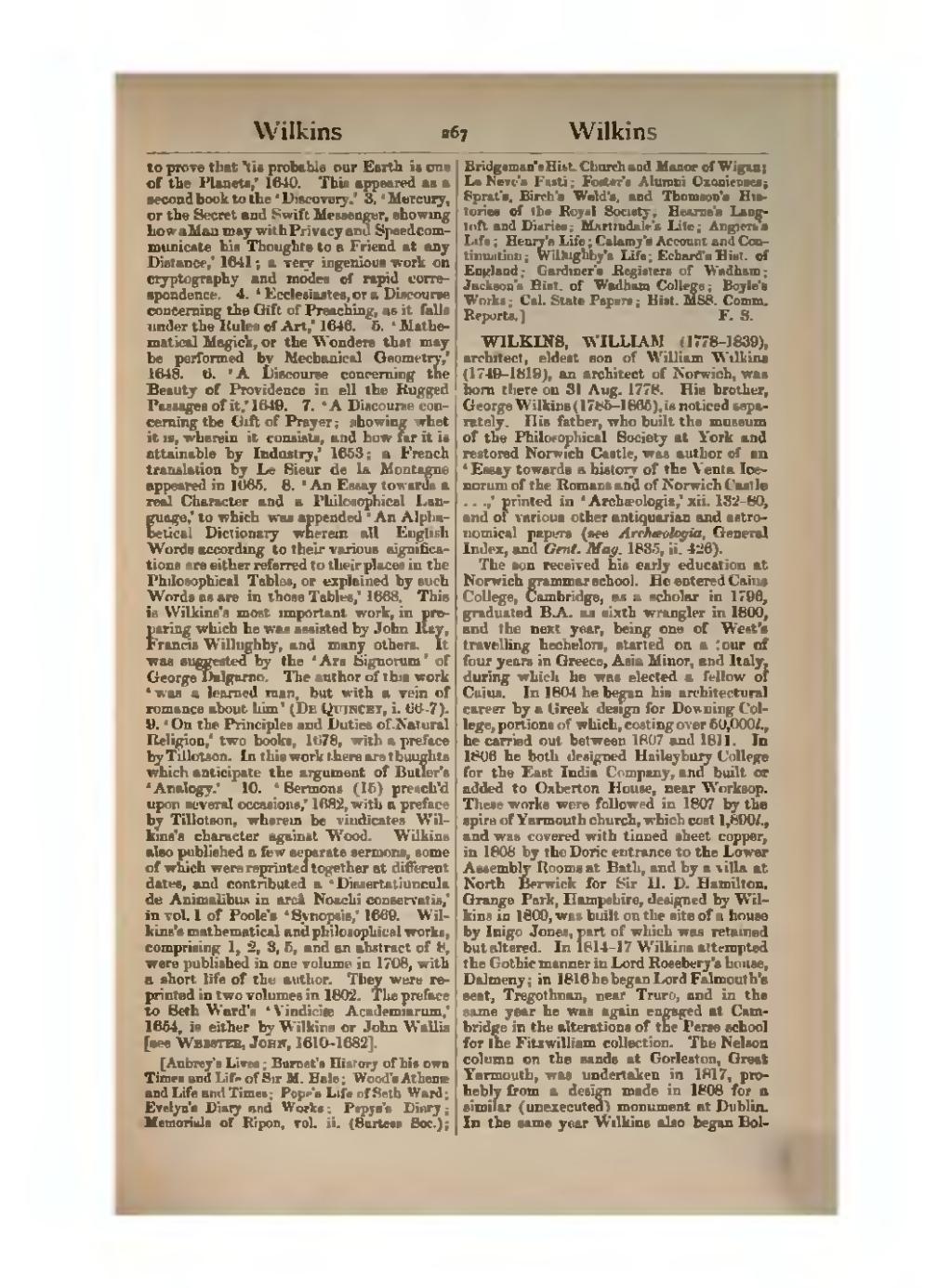- to prove that 'tis probable our Earth is one of the Planets,’ 1640. This appeared as a second book to the ‘Discovery.’
- ‘Mercury, or the Secret and Swift Messenger, showing how a Man may with Privacy and Speed communicate his Thoughts to a Friend at any Distance,’ 1641; a very ingenious work on cryptography and modes of rapid correspondence.
- ‘Ecclesiastes, or a Discourse concerning the Gift of Preaching, as it falls under the Rules of Art,’ 1646.
- ‘Mathematical Magick, or the Wonders that may be performed by Mechanical Geometry,’ 1648.
- ‘A Discourse concerning the Beauty of Providence in all the Rugged Passages of it,’ 1649.
- ‘A Discourse concerning the Gift of Prayer; showing what it is, wherein it consists, and how far it is attainable by Industry,’ 1653; a French translation by Le Sieur de la Montagne appeared in 1665.
- ‘An Essay towards a real Character and a Philosophical Language,’ to which was appended ‘An Alphabetical Dictionary wherein all English Words according to their various significations are either referred to their places in the Philosophical Tables, or explained by such Words as are in those Tables,’ 1668. This is Wilkins's most important work, in preparing which he was assisted by John Ray, Francis Willughby, and many others. It was suggested by the ‘Ars Signorum’ of George Dalgarno. The author of this work ‘was a learned man, but with a vein of romance about him’ (De Quincey, i. 66–7).
- ‘On the Principles and Duties of Natural Religion,’ two books, 1678, with a preface by Tillotson. In this work there are thoughts which anticipate the argument of Butler's ‘Analogy.’
- ‘Sermons (15) preach'd upon several occasions,’ 1682, with a preface by Tillotson, wherein he vindicates Wilkins's character against Wood.
Wilkins also published a few separate sermons, some of which were reprinted together at different dates, and contributed a ‘Dissertatiuncula de Animalibus in arcâ Noachi conservatis,’ in vol. 1 of Poole's ‘Synopsis,’ 1669. Wilkins's mathematical and philosophical works, comprising 1, 2, 3, 5, and an abstract of 8, were published in one volume in 1708, with a short life of the author. They were reprinted in two volumes in 1802. The preface to Seth Ward's ‘Vindiciæ Academiarum,’ 1654, is either by Wilkins or John Wallis [see Webster, John, (1610–1682)].
[Aubrey's Lives; Burnet's History of his own Times and Life of Sir M. Hale; Wood's Athenæ and Life and Times; Pope's Life of Seth Ward; Evelyn's Diary and Works; Pepys's Diary; Memorials of Ripon, vol. ii. (Surtees Soc.); Bridgeman's Hist. Church and Manor of Wigan; Le Neve's Fasti; Foster's Alumni Oxonienses; Sprat's, Birch's Weld's, and Thomson's Histories of the Royal Society; Hearne's Langtoft and Diaries; Martindale's Life; Angiers's Life; Henry's Life; Calamy's Account and Continuation; Willughby's Life; Echard's Hist. of England; Gardiner's Registers of Wadham; Jackson's Hist. of Wadham College; Boyle's Works; Cal. State Papers; Hist. MSS. Comm. Reports.]
WILKINS, WILLIAM (1778–1839), architect, eldest son of William Wilkins (1749–1819), an architect of Norwich, was born there on 31 Aug. 1778. His brother, George Wilkins (1785–1865) [q. v.], is noticed separately. His father, who built the museum of the Philosophical Society at York and restored Norwich Castle, was author of an ‘Essay towards a history of the Venta Icenorum of the Romans and of Norwich Castle …,’ printed in ‘Archæologia,’ xii. 132–80, and of various other antiquarian and astronomical papers (see Archæologia, General Index, and Gent. Mag. 1835, ii. 426).
The son received his early education at Norwich grammar school. He entered Caius College, Cambridge, as a scholar in 1796, graduated B.A. as sixth wrangler in 1800, and the next year, being one of West's travelling bachelors, started on a tour of four years in Greece, Asia Minor, and Italy, during which he was elected a fellow of Caius. In 1804 he began his architectural career by a Greek design for Downing College, portions of which, costing over 50,000l., he carried out between 1807 and 1811. In 1806 he both designed Haileybury College for the East India Company, and built or added to Osberton House, near Worksop. These works were followed in 1807 by the spire of Yarmouth church, which cost 1,890l., and was covered with tinned sheet copper, in 1808 by the Doric entrance to the Lower Assembly Rooms at Bath, and by a villa at North Berwick for Sir H. D. Hamilton. Grange Park, Hampshire, designed by Wilkins in 1809, was built on the site of a house by Inigo Jones, part of which was retained but altered. In 1814–17 Wilkins attempted the Gothic manner in Lord Rosebery's house, Dalmeny; in 1816 he began Lord Falmouth's seat, Tregothnan, near Truro, and in the same year he was again engaged at Cambridge in the alterations of the Perse school for the Fitzwilliam collection. The Nelson column on the sands at Gorleston, Great Yarmouth, was undertaken in 1817, probably from a design made in 1808 for a similar (unexecuted) monument at Dublin. In the same year Wilkins also began Bol-
